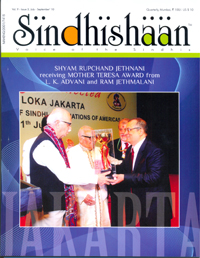Ram Jawhrani’s address at the
Jakarta International Sindhi Sammelan

With the dawn of Independence all Indians heaved a sigh of relief. But simultaneously, a great disaster struck the Sindhi community. Along with Independence came Partition which divided not only the country but the entire Sindhi community. For Sindhis it meant leaving their mother land. At such times a person loses his intellect, brain and sanity. But somehow Sindhis remained stable and sane, struggled a lot and just like the elements – air, water and fire find their way, Sindhis also created their own paths for themselves.
Today when you look at the globe, there isn’t a place where Sindhis haven’t left their imprint. Wherever they have settled they have beautified their surroundings with the fragrance of their identity and have left an inerasable mark. They have made India and the entire world their home.
In India all the other communities have their own room inside this home – their own state. All other communities have a piece of land to call their own. Therefore their language and culture is not endangered except in the case of Sindhis; and this is a painful fact because of which we have imbibed the traditions and cultures of others and in the process lost our own traditions and culture, and It is because of this that the elders of our community are not at ease and are worried.
At every Sindhi function, meeting, seminar, conference, get-together, fair, sammelan etc. one slogan is always heard, ‘Save the Sindhi language and culture’. There is a grievance against the youth that they do not speak their mother tongue while the youth look at the elders inquiringly - what is to be saved and preserved? What is Sindhyat? But have we in the true sense made sincere efforts to pass on this rich treasure of our culture and heritage to the younger generation? How can we then tell them to preserve it? Firstly, its our duty to acquaint our younger generation with the fact that Sindhis are the inheritors of a wonderful legacy. Our heritage is rich and priceless. Sindhyat is not the name of something or some object, but the name given to feelings and passion which makes one a Sindhi.
Thousands of years ago, humans living in caves slowly started using their intellect and in various parts of the world different communities emerged. Community Living and traditions were established. History is proof that on the land of Sindh emerged the beautiful legacy of humanity whose existence can very well be viewed in the excavations of Mohen-jo-daro. With time the experience of our ancestors, elders and scholars was given the name of Sindhyat. This included our life-style, diet patterns, thinking patterns, social behavior, marriage, traditions, beliefs, rites, rituals etc. These traditions and behavioral patterns make us different from others. Each generation passes this on to the next generation with some alterarions in accordance with the changing times and conditions. I feel that our generation is lagging behind in passing this on to the next generation and the younger generation has only half and maybe incorrect information about our culture and traditions. When they look at other communities they see Mahatma Gandhi and Garba raas in Gujaratis, Rabindranath Tagore and Subhash Chandra Bose in Bengalis, Lokmanya Tilak and Ganpati Pooja in Maharashtrians. They are confused and ask what do we posses to feel proud about. We have to educate them that we have some of the most brilliant and legendary poets like Shah, Sami and Sachal who are on par with Tagore and Shakespeare. Our Sindhi community also produced revolutionary freedom fighters like Hemu Kalani who embraced the gallows smilingly. If Gujaratis have the Garba Raas then we have Chej and Jhoomer, If Punjabis have Bhagra then we have Bhagat. We have scholars like Bhagwan Gidwani whose book ‘Return of Aryans’ enlightened the whole world about our ancient culture. Wonderful Singers like Bhagat Kanwar Ram were also born in our community.
Sindhis are forerunners in every field, be it the formation of Azad Hind Sena of Subhash Chandra Bose or the establishment of Shantiniketan of Rabindranath Tagore or the clarion call of Mahatma Gandhi for the freedom of the nation. Sindhis have responded to each and every national call with their heart and soul.
Language is the prime medium for the passage of this rich treasure of our heritage and culture from one generation to the next. This has been the hurdle and hence we have to search for a new path or else this rich and priceless treasure will vanish and get buried in the sands of time.
The new path according to me is art - consisting of music, dance and drama through which we can educate our younger generation about our rich past, culture and history. Through dance and drama we can beautifully decorate and present our traditions, beliefs, way of life, customs, rites and rituals etc. To some extent we have been successful in doing so. Today in small towns and big cities wherever Sindhis reside Jhulelal temples have been built. Social organizations have been set up for the promotion of language which organize meetings, seminars, conferences, cultural programmes etc. Now the question is not of moving forward but more importantly in which direction to move. We cannot just sit on the wooden horse and command it to move, which may just wobble but never move. We have to search and prepare new artists for stage and encourage litterateurs. We have to create this realization amongst our children, regarding our identity of being Sindhi. They shouldn’t be of the opinion that only those who are born in Sindh are Sindhis but even those who reside and were born in other countries are also Sindhis. Lion’s cubs will be known as lions no matter where they are born. So come, lets pray to Lord Jhulelal that all Sindhis be united and live in peace and harmony.


